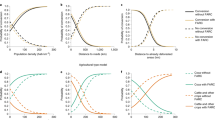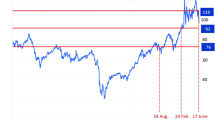Abstract
The Russia–Ukraine War is impacting global food systems, which may trigger global cropland expansion and consequently lead to biodiversity loss far from war zones. To quantify such impacts on biodiversity, we simulated the global cropland expansion provoked by the reshaping of international virtual cropland flows under different war scenarios and conducted a biodiversity impact assessment. The results indicate that, in the baseline situation (33.57% reduction in Ukraine’s exports), the war would result in an additional 8.48 Mha of cropland expansion compared with the ‘no war’ scenario. This cropland expansion would impact biodiversity most in countries such as the United States, Spain, France, India and Brazil. The cessation of Russia’s participation in the Black Sea Grain Initiative would lead to a doubling of cropland expansion and biodiversity loss compared with the baseline situation. If the conflict deteriorates further, that is, no exports from Russia and Ukraine, cropland expansion and biodiversity loss would increase by up to 2.9 and ∼4.5 times, respectively. These findings highlight the need for proactive measures to mitigate the impact of this war on biodiversity and suggest that actions to implement the post-2020 Global Biodiversity Framework should take into account the potential impacts of conflicts on biodiversity.
This is a preview of subscription content, access via your institution
Access options
Access Nature and 54 other Nature Portfolio journals
Get Nature+, our best-value online-access subscription
$29.99 / 30 days
cancel any time
Subscribe to this journal
Receive 12 digital issues and online access to articles
$119.00 per year
only $9.92 per issue
Buy this article
- Purchase on Springer Link
- Instant access to full article PDF
Prices may be subject to local taxes which are calculated during checkout




Similar content being viewed by others
Data availability
The GTAP Database is available at https://www.gtap.agecon.purdue.edu/databases/. The Multi-Regional Input-Output database adopted to investigate virtual agricultural land flows can be found at https://doi.org/10.5281/zenodo.3993659. The datasets of characterization factors adopted to calculate the biodiversity loss due to land transformation are available free of charge in the supporting information of the previous study at https://doi.org/10.1021/acs.est.5b02507.
Code availability
All data processing and analysis were conducted in ArcGIS (v.10.7), MATLAB (v.2021), GTAP (v.10) and Microsoft Excel (v.2016). The code and model output files are available at https://doi.org/10.5281/zenodo.10546479.
References
Behnassi, M. & El Haiba, M. Implications of the Russia–Ukraine war for global food security. Nat. Hum. Behav. 6, 754–755 (2022).
The war in Ukraine is exposing gaps in the world’s food-systems research. Nature 604, 217–218 (2022).
Tollefson, J. What the war in Ukraine means for energy, climate and food. Nature 604, 232–233 (2022).
Bentley, A. Broken bread—avert global wheat crisis caused by invasion of Ukraine. Nature 603, 551 (2022).
Carriquiry, M., Dumortier, J. & Elobeid, A. Trade scenarios compensating for halted wheat and maize exports from Russia and Ukraine increase carbon emissions without easing food insecurity. Nat. Food 3, 847–850 (2022).
Potapov, P. et al. Global maps of cropland extent and change show accelerated cropland expansion in the twenty-first century. Nat. Food 3, 19–28 (2022).
Kehoe, L. et al. Biodiversity at risk under future cropland expansion and intensification. Nat. Ecol. Evol. 1, 1129–1135 (2017).
Jouf, C. & Lawson, L. European farmers’ responses to higher commodity prices: cropland expansion or forestlands preservation? Ecol. Econ. 191, 107243 (2022).
Wimberly, M. C. et al. Cropland expansion and grassland loss in the eastern Dakotas: new insights from a farm-level survey. Land Use Policy 63, 160–173 (2017).
Lark, T. J., Spawn, S. A., Bougie, M. & Gibbs, H. K. Cropland expansion in the United States produces marginal yields at high costs to wildlife. Nat. Commun. 11, 4295 (2020).
Molotoks, A. et al. Global projections of future cropland expansion to 2050 and direct impacts on biodiversity and carbon storage. Glob. Change Biol. 24, 5895–5908 (2018).
Myers, N., Mittermeier, R. A., Mittermeier, C. G., da Fonseca, G. A. & Kent, J. Biodiversity hotspots for conservation priorities. Nature 403, 853–858 (2000).
Outhwaite, C. L., McCann, P. & Newbold, T. Agriculture and climate change are reshaping insect biodiversity worldwide. Nature 605, 97–102 (2022).
Clark, D. Wheat prices have surged over 60% this year, driven by the war in Ukraine. Investopedia https://www.investopedia.com/wheat-price-spike-fuels-inflation-5272396 (2022).
June 2022 Food Price Monitoring and Analysis (FPMA) Bulletin (FAO, 2022).
Liu, J., Balmford, A. & Bawa, K. S. Fuel, food and fertilizer shortage will hit biodiversity and climate. Nature 604, 425 (2022).
Strange, N., Geldmann, J., Burgess, N. D. & Bull, J. W. Policy responses to the Ukraine crisis threaten European biodiversity. Nat. Ecol. Evol. 6, 1048–1049 (2022).
Alexander, P. et al. High energy and fertilizer prices are more damaging than food export curtailment from Ukraine and Russia for food prices, health and the environment. Nat. Food 4, 84–95 (2023).
GTAP v.10 Data Base (Purdue University, 2019); https://www.gtap.agecon.purdue.edu/about/project.asp
McDougall, R. A., Walmsley, T. L., Golub, A., Ianchovichina, E. I. & Itakura, K. in Dynamic Modeling and Applications for Global Economic Analysis (eds Ianchovichina, E. & Walmsley, T. L.) 120–135 (Cambridge Univ. Press, 2012).
Hull, V. & Liu, J. Telecoupling: a new frontier for global sustainability. Ecol. Soc. 23, 41 (2018).
Liu, J. Leveraging the metacoupling framework for sustainability science and global sustainable development. Natl Sci. Rev. 10, nwad090 (2023).
FAOSTAT (FAO, accessed March 2023); https://www.fao.org/faostat/en/#data
Cabernard, L. & Pfister, S. A highly resolved MRIO database for analyzing environmental footprints and Green Economy Progress. Sci. Total Environ. 755, 142587 (2021).
ENG Export of Agriproducts (Ministry of Agrarian Policy and Food of Ukraine, accessed March 2023); https://public.tableau.com/app/profile/fsuw/viz/ENGExportofAgriproducts/Dashboard1
Zabel, F. et al. Global impacts of future cropland expansion and intensification on agricultural markets and biodiversity. Nat. Commun. 10, 2844 (2019).
Song, X. P. et al. Massive soybean expansion in South America since 2000 and implications for conservation. Nat. Sustain. 4, 784–792 (2021).
Koellner, T. et al. UNEP-SETAC guideline on global land use impact assessment on biodiversity and ecosystem services in LCA. Int. J. Life Cycle Assess. 18, 1188–1202 (2013).
de Baan, L., Mutel, C. L., Curran, M., Hellweg, S. & Koellner, T. Land use in life cycle assessment: global characterization factors based on regional and global potential species extinction. Environ. Sci. Technol. 47, 9281–9290 (2013).
Canals, L. M. I. et al. Key elements in a framework for land use impact assessment within LCA. Int. J. Life Cycle Assess. 12, 5–15 (2007).
Chaudhary, A., Verones, F., de Baan, L. & Hellweg, S. Quantifying land use impacts on biodiversity: combining species-area models and vulnerability indicators. Environ. Sci. Technol. 49, 9987–9995 (2015).
Chaudhary, A. & Kastner, T. Land use biodiversity impacts embodied in international food trade. Glob. Environ. Change 38, 195–204 (2016).
Kier, G. et al. A global assessment of endemism and species richness across island and mainland regions. Proc. Natl Acad. Sci. USA 106, 9322–9327 (2009).
Curran, M., Hellweg, S. & Beck, J. Is there any empirical support for biodiversity offset policy? Ecol. Appl. 24, 617–632 (2014).
Ukraine, Russia agree to export grain, ending a standoff that threatened food supply. Associated Press (22 July 2022).
Fuchs, R. et al. Why the US–China trade war spells disaster for the Amazon. Nature 567, 451–454 (2019).
Chaudhary, A., Pfister, S. & Hellweg, S. Spatially explicit analysis of biodiversity loss due to global agriculture, pasture and forest land use from a producer and consumer perspective. Environ. Sci. Technol. 50, 3928–3936 (2016).
Chung, M. G. & Liu, J. International food trade benefits biodiversity and food security in low-income countries. Nat. Food 3, 349–355 (2022).
Strassburg, B. B. et al. Moment of truth for the Cerrado hotspot. Nat. Ecol. Evol. 1, 0099 (2017).
Heilmayr, R., Rausch, L. L., Munger, J. & Gibbs, H. K. Brazil’s Amazon Soy Moratorium reduced deforestation. Nat. Food 1, 801–810 (2020).
Bogonos, M. Agricultural Outlook Ukraine – 2050 Projections for Crops (Kyiv School of Economics, 2023).
Sun, Z., Scherer, L., Zhang, Q. & Behrens, P. Adoption of plant-based diets across Europe can improve food resilience against the Russia–Ukraine conflict. Nat. Food 3, 905–910 (2022).
Jägermeyr, J. et al. Climate impacts on global agriculture emerge earlier in new generation of climate and crop models. Nat. Food 2, 873–885 (2021).
Stadler, K. et al. EXIOBASE 3: developing a time series of detailed environmentally extended multi-regional input-output tables. J. Ind. Ecol. 22, 502–515 (2018).
Qin, Y. et al. Snowmelt risk telecouplings for irrigated agriculture. Nat. Clim. Change 12, 1007 (2022).
Qian, X. Y., Liang, Q. M., Liu, L. J., Zhang, K. & Liu, Y. Key points for green management of water-energy-food in the Belt and Road Initiative: resource utilization efficiency, final demand behaviors and trade inequalities. J. Clean. Prod. 362, 132386 (2022).
Zhai, L., Yuan, S. & Feng, Y. The economic effects of export restrictions imposed by major grain producers. Agric. Econ. 68, 11–19 (2022).
Li, X. et al. A cellular automata downscaling based 1 km global land use datasets (2010–2100). Sci. Bull. 61, 1651–1661 (2016).
Cao, B. et al. A 1 km global cropland dataset from 10 000 BCE to 2100 CE. Earth Syst. Sci. Data 13, 5403–5421 (2021).
Li, X. et al. A new global land-use and land-cover change product at a 1-km resolution for 2010 to 2100 based on human–environment interactions. Ann. Am. Assoc. Geogr. 107, 1040–1059 (2017).
Olson, D. M. et al. Terrestrial Ecoregions of the World: A New Map of Life on Earth: a new global map of terrestrial ecoregions provides an innovative tool for conserving biodiversity. BioScience 51, 933–938 (2001).
Acknowledgements
L.C. acknowledges support from the National Key R&D Program of China (2022YFD1500205). J.L. acknowledges support from the US National Science Foundation (1924111 and 2118329), the USDA NIFA (2023-68012-39076) and Michigan AgBioResearch. We thank S. Nichols for helpful comments on an earlier version of this paper.
Author information
Authors and Affiliations
Contributions
L.C. and J.L. conceptualized the project; L.C., X.L. and A.L. designed the methodology; L.C. and A.L. undertook formal analyses; L.C., X.L., A.L. and W.H. performed the investigations; L.C. and J.L. supervised the work; J.H. and T.B. validated the results; L.C., A.L., X.L. and W.H. visualized the data; L.C. wrote the first draft; J.L. and Z.G. contributed to the review and editing of the paper.
Corresponding authors
Ethics declarations
Competing interests
The authors declare no competing interests.
Peer review
Peer review information
Nature Sustainability thanks Damià Barceló, Peter Alexander, Nathalie J. Lambrecht and the other, anonymous, reviewer(s) for their contribution to the peer review of this work.
Additional information
Publisher’s note Springer Nature remains neutral with regard to jurisdictional claims in published maps and institutional affiliations.
Supplementary information
Supplementary Information
Supplementary Figs. 1–9 and Tables 1–5.
Supplementary Data
Food price changes and food consumption changes under different scenarios.
Rights and permissions
Springer Nature or its licensor (e.g. a society or other partner) holds exclusive rights to this article under a publishing agreement with the author(s) or other rightsholder(s); author self-archiving of the accepted manuscript version of this article is solely governed by the terms of such publishing agreement and applicable law.
About this article
Cite this article
Chai, L., Liu, A., Li, X. et al. Telecoupled impacts of the Russia–Ukraine war on global cropland expansion and biodiversity. Nat Sustain 7, 432–441 (2024). https://doi.org/10.1038/s41893-024-01292-z
Received:
Accepted:
Published:
Issue Date:
DOI: https://doi.org/10.1038/s41893-024-01292-z
This article is cited by
-
Warâs cascading global effects
Nature Sustainability (2024)



